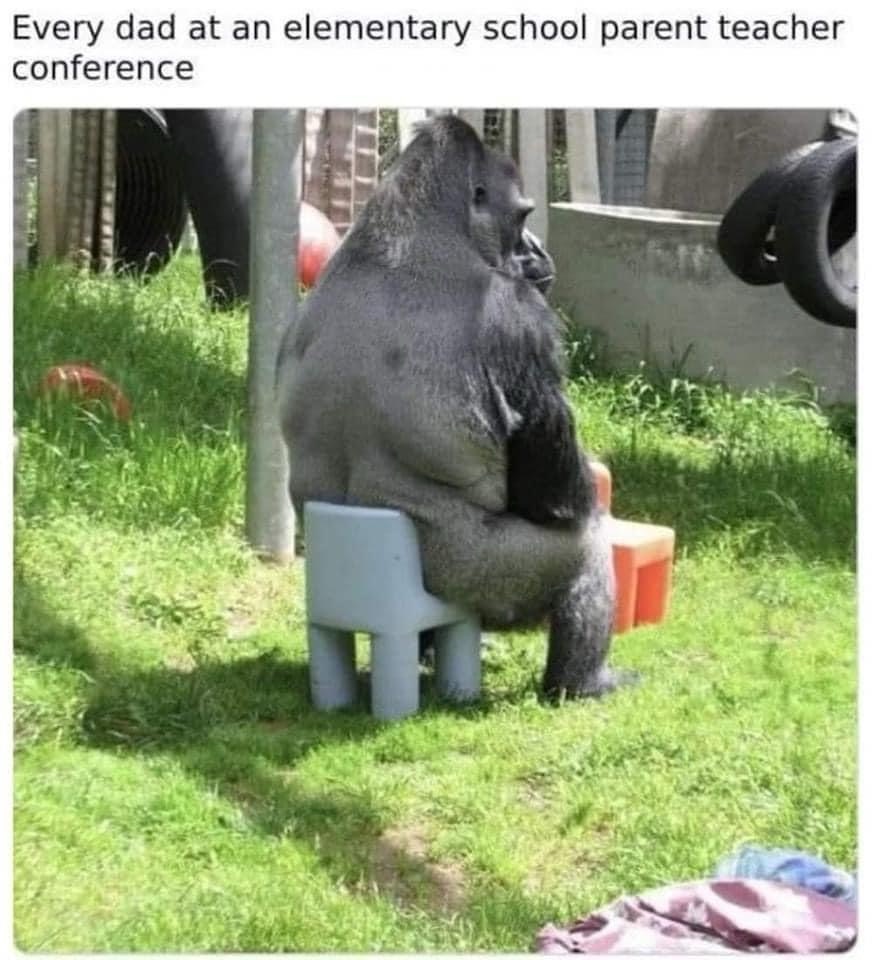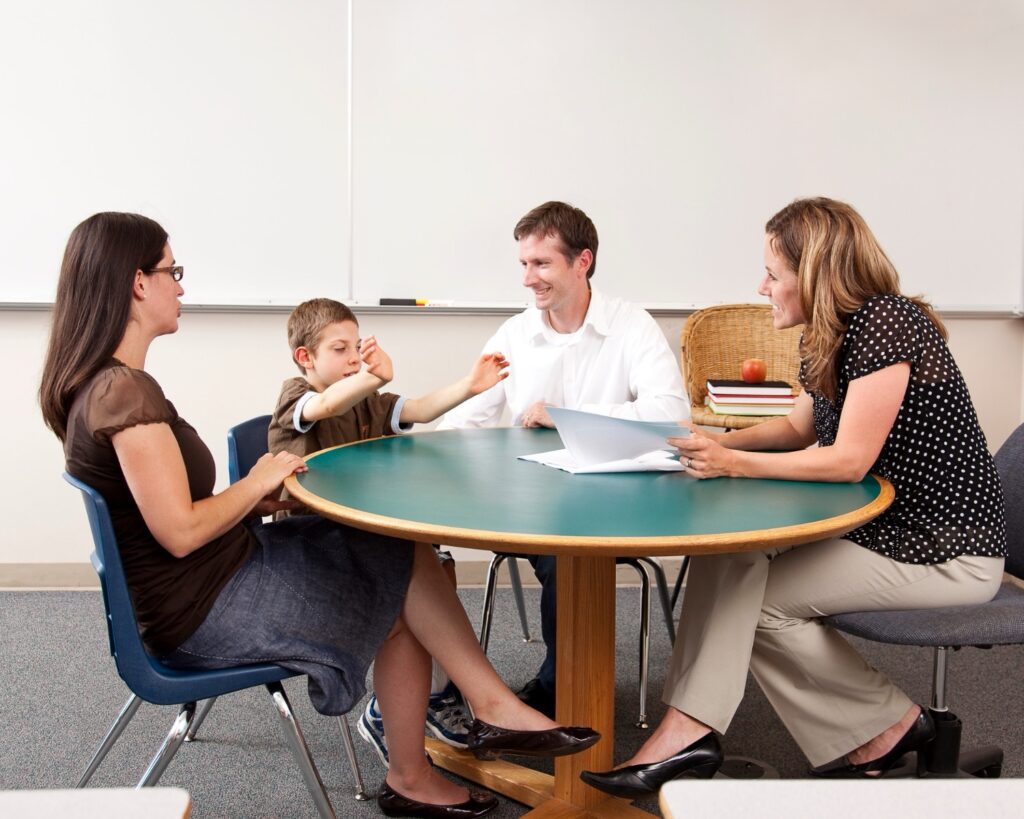Picture this: You’re a dad, accustomed to the great outdoors of office life, sports fields, or the comfort of your man cave. Suddenly, you find yourself navigating the wilds of an elementary school parent-teacher conference. The scene is more intense than a fourth-quarter tiebreaker or a last-minute project deadline. You’re in the land of pint-sized chairs, where the walls are a mosaic of finger paintings and glitter, and the air smells distinctly of cafeteria lunches and whiteboard markers.

This is no ordinary expedition; it’s a foray into the heart of your kid’s world, and let’s be honest, it can feel as out of place as a gorilla sitting in a dollhouse chair. So, gear up, dads. It’s time to dive into the untamed wilderness of parent-teacher conferences, with a dash of humor to guide you through.
The Pre-Conference Pep Talk
Before you venture into the tiny-chair-laden jungle, it’s crucial to have a game plan. Just like prepping for the big game or strategizing for that all-important business meeting, heading into a parent-teacher conference requires a bit of mental preparation. You’re not just any spectator in the stands; you’re the coach, the MVP, the dad who’s about to get the lowdown on how his kid is playing the academic field.
First off, remember why you’re there: to support your kid, to learn, and to communicate. It’s not about defending every scribble or missed homework assignment. It’s about understanding how you can help your child thrive, both in and out of the classroom. And hey, it’s also about showing up and demonstrating that when it comes to being involved in your kid’s life, you’re there, front and center, even if it means sitting in a chair that barely supports one butt cheek.
Navigating these conferences can be as tricky as trying to assemble any piece of furniture without the instructions. Questions are your best tools: ask about your child’s strengths, areas for improvement, and how you can extend that support at home. Be ready to listen, really listen, even if what you hear isn’t all gold stars and perfect scores.
And for those dads looking to make the home a continuation of the positive vibes and learning experiences from school, diving into resources like “10 Tips for Creating a Happy and Healthy Family Life” can be a game-changer. It’s all about creating an environment where your kid feels supported, motivated, and part of a team — your family team.
So, take a deep breath, practice your most understanding nod, and maybe do a few squats to prepare for the inevitable tiny chair. You’ve got this, dad. The parent-teacher conference is just another adventure in the great expedition of parenting, and with the right attitude, you can navigate it like the pro you are.

What’s the Deal with All the Artwork?
Ever wondered why every inch of wall space in an elementary classroom is covered with artwork that ranges from abstract expressions of the alphabet to colorful depictions of family members that look more like alien life forms? As you sit there, knees bunched up to your chest in a chair designed for someone a quarter of your size, you can’t help but scan the room, eyes landing on these masterpieces of childhood imagination.
This gallery of pint-sized Picassos isn’t just for show. It’s a visual diary of every child’s journey through learning, creativity, and self-expression. Each piece of paper plastered on the wall represents a story, a lesson learned, or a moment of pride for these kids. And as a dad, you’re not just a casual observer; you’re a key player in encouraging this creativity. Whether it’s a scribble or a detailed landscape, showing interest in your child’s artwork can boost their confidence and encourage them to explore their talents further.
But here’s the kicker: among this sea of artwork, you might just spot something familiar—a stick figure with an oversized head, perhaps, standing next to a slightly larger stick figure, both grinning under a crudely drawn sun. Yes, that’s you, according to your child, captured in all your stick-figure glory, proudly displayed for all to see.
So, as you navigate the wilderness of the parent-teacher conference, take a moment to appreciate these expressions of creativity. Ask your child about their artwork; what inspired it, what story it tells. It’s a simple way to show you care, not just about their academic performance but about the things that bring them joy and pride. And who knows? You might just leave the conference with a new piece of art for your fridge, a badge of honor in the world of dadhood.

Can We Bring the Classroom Charm Home?
As you sit there, surrounded by a kaleidoscope of children’s art and educational posters, a thought might cross your mind: “Can I bring some of this vibrant, educational charm into my kid’s room at home?” The answer is a resounding yes. Translating the lively and nurturing environment of a classroom into your child’s personal space can be a fantastic way to fuel their imagination and learning outside of school hours.
Creating an environment that mirrors the positive aspects of their classroom can make learning and creativity a seamless part of their daily life. Consider incorporating educational yet fun elements into their room decor. Animal wall art, for example, not only brightens up the space but also sparks curiosity about the natural world. For dads looking to add a touch of wildlife charm to their child’s room, exploring options like the “Best Adorable Animal Wall Art for Kids” can offer some creative inspiration. This type of decor can transform a plain room into a vibrant learning sanctuary, where every day is an adventure.
Bringing elements of the classroom home doesn’t stop at wall art. Think about setting up a small reading nook or a creativity corner equipped with art supplies, mirroring the interactive stations they’re accustomed to at school. It’s all about creating a space where your child feels encouraged to explore, learn, and express themselves, just as they do in the classroom.
Incorporating educational decor and learning zones into your child’s room not only enhances their learning experience but also serves as a constant reminder of the support and interest you, as a dad, have in their educational journey. So, why not take a leaf out of the classroom’s book and bring some of that engaging and supportive environment home? For more inspiration on how to get started, check out this guide on adorable animal wall art for kids that can help bring the wonders of the wild into your child’s everyday spaces.

How Can I Be More Involved in My Child’s Learning Journey?
It’s a question that crosses the mind of many dads as they navigate the tiny desks and colorful walls of parent-teacher conferences. Sitting there, in a chair that feels more suited to a teddy bear, you realize that being a part of your child’s educational journey is about more than just showing up for meetings and nodding along. It’s about actively engaging in their learning and development, even if it means stepping out of your comfort zone.
Being involved doesn’t necessarily mean you have to take up teaching duties at home (though if you’re up for that, more power to you!). It can be as simple as dedicating time each day to ask about what they learned, reading together, or even turning mundane tasks into fun, educational games. Show an interest in their homework, not as a taskmaster, but as a curious observer eager to learn what they’re excited about.
And here’s a pro tip: get involved in their school community whenever possible. Attend school events, volunteer for field trips, or participate in school projects. These actions speak volumes, showing your child that you value their education and are a supportive pillar in their learning journey.
Remember, your involvement in your child’s education isn’t just about academic achievement; it’s about building a stronger relationship with your child and showing them that learning can be a shared adventure. So, as you unfold yourself from that child-sized chair and say goodbye to the world of elementary school conferences, carry with you the resolve to be an active participant in your child’s learning journey, making it richer and more meaningful for you both.
The Importance of Dad’s Presence at Parent-Teacher Conferences
Why is it important for dads to attend parent-teacher conferences?
Attending parent-teacher conferences is crucial for dads because it demonstrates to your child that you are deeply invested in their education and well-being. It sends a clear message that learning is a family priority and that both parents are united in their support. Moreover, it allows dads to gain firsthand insights into their child’s academic performance, social interactions, and any areas that might need extra attention or encouragement.
What can dads learn from these conferences?
Dads can learn a lot from attending parent-teacher conferences, including understanding their child’s strengths and areas for improvement, the teacher’s expectations, and how the classroom dynamics influence their child’s learning experience. These meetings also provide a platform to discuss the child’s interests, learning styles, and any concerns that may not be evident through report cards or homework assignments.
How can dads prepare for a productive conference?
Preparation can turn a routine meeting into a valuable opportunity for growth and connection. Consider jotting down a few questions or concerns you have beforehand, such as asking for specific examples of your child’s work or inquiring about ways to support learning at home. Being prepared shows the teacher that you are engaged and ready to collaborate on your child’s education.
How can dads follow up after the conference to support their child’s education?
The conference is just the starting point. Following up could mean setting goals with your child based on the teacher’s feedback, scheduling regular check-ins to discuss schoolwork, or creating a plan to address any challenges. It might also involve communicating with the teacher to update them on your child’s progress or to continue the dialogue on how best to support your child.
Is it important for dads to communicate with their children about the conference?
Absolutely. Discussing the conference with your child can help demystify the process and reinforce that education is a team effort. It’s a chance to celebrate their successes, address any concerns, and show that you’re in their corner, ready to tackle any challenges together.
By stepping into the classroom and actively participating in these discussions, dads play a pivotal role in shaping their child’s attitude towards education and life-long learning. It’s about building a foundation of support, curiosity, and resilience that will serve your child well beyond their elementary school years.
As an Amazon Associate we earn from qualifying purchases through some links in our articles.



